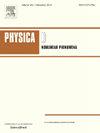Flow-induced variations in odour boundary formation
IF 2.7
3区 数学
Q1 MATHEMATICS, APPLIED
引用次数: 0
Abstract
Odour tracking is vital for many biological organisms, underpinning behaviours such as foraging and navigation. However, due to the lack of systematic investigation, relevant applications remain underdeveloped. This study simulates the dispersion of odours from a single source, discussing the concept of an ‘odour boundary’. Utilising Schmidt numbers ranging from 0.96 to 3.08 and Reynolds numbers from 195 to 47,665, we explored the structure and variability of the odour boundary at different concentrations. Results demonstrate that the odour boundary width remains largely consistent within the range, with minor variations at lower . As increases, the boundary narrows, although low values limit odour spread due to incomplete lateral flow development. Additionally, the potential core length inversely affects the odour boundary width; a more extended core facilitates downstream airstream propagation while restricting lateral dispersion. When exceeds 10,000, the boundary width greatly decreases and stabilises. High-concentration regions within the lateral boundaries contract with higher wind speeds and at specific high , the odour distribution adopts an M-shaped pattern rather than a bell-shaped curve, suggesting that the highest concentration may not align with the centreline. This supports the notion of an ‘odour barrier’ and could elucidate biological tracking mechanisms, such as those in silk moths. Insights from this study may inform robotic navigation systems, enabling more efficient odour source localisation in turbulent environments.
流动引起的气味边界形成的变化
气味追踪对许多生物来说至关重要,是觅食和导航等行为的基础。然而,由于缺乏系统的研究,相关的应用仍不发达。本研究模拟了单一来源的气味分散,讨论了“气味边界”的概念。利用施密特数Sc从0.96到3.08,雷诺数Re从195到47,665,我们探索了不同浓度下气味边界的结构和变异性。结果表明,气味边界宽度在Sc范围内基本保持一致,在较低Re时变化较小。随着Re的增加,边界变窄,尽管低Re值由于不完全的横向流动发展限制了气味的传播。此外,潜在核心长度与气味边界宽度成反比;一个更大的核心有利于下游气流传播,同时限制横向扩散。当Re超过10,000时,边界宽度大大减小并趋于稳定。横向边界内的高浓度区域随着风速的增大而收缩,在特定的高Re下,气味分布呈m型而不是钟形曲线,这表明最高浓度可能不与中心线一致。这支持了“气味屏障”的概念,并可以阐明生物追踪机制,例如蚕蛾的生物追踪机制。这项研究的见解可能会为机器人导航系统提供信息,在动荡的环境中实现更有效的气味源定位。
本文章由计算机程序翻译,如有差异,请以英文原文为准。
求助全文
约1分钟内获得全文
求助全文
来源期刊

Physica D: Nonlinear Phenomena
物理-物理:数学物理
CiteScore
7.30
自引率
7.50%
发文量
213
审稿时长
65 days
期刊介绍:
Physica D (Nonlinear Phenomena) publishes research and review articles reporting on experimental and theoretical works, techniques and ideas that advance the understanding of nonlinear phenomena. Topics encompass wave motion in physical, chemical and biological systems; physical or biological phenomena governed by nonlinear field equations, including hydrodynamics and turbulence; pattern formation and cooperative phenomena; instability, bifurcations, chaos, and space-time disorder; integrable/Hamiltonian systems; asymptotic analysis and, more generally, mathematical methods for nonlinear systems.
 求助内容:
求助内容: 应助结果提醒方式:
应助结果提醒方式:


